Curious about white birds in Michigan? I’ve researched 15 species, from sky hunters to serene waders and all calling Michigan’s diverse habitats home. Their snowy feathers are a sight to behold against the state’s lush backdrops. Let’s dive into their worlds, discover their quirks, and learn where to find them in the Great Lakes State.
Here we’ll learn about 15 different types of White Birds in Michigan
Here are the main points:
- Michigan is home to a variety of white birds, including birds of prey, wading birds, water birds, forest birds, and backyard birds.
- Some of the white birds found in Michigan include the snowy owl, great blue heron, mute swan, white-breasted nuthatch, and rock pigeon.
- White bird sightings in Michigan’s forests, backyards, and bodies of water are not uncommon, but rare sightings of birds like the whooping crane and Ross’s goose have also been recorded.
- If you’re interested in birdwatching, we’ll provide tips on the best times, locations, and resources for spotting white birds in Michigan.
- Respecting the birds’ habitats and conserving their environments is crucial in ensuring their continued presence in the state.
White Birds of Prey in Michigan
If you have ever marveled at the majestic beauty of white birds of prey Soaring through the skies, you’ll be delighted to know that Michigan is home to some remarkable species, including those with striking black and white plumage. These white hunters, with their sharp talons and keen eyesight, add an enchanting touch to the state’s diverse bird population. Let’s take a closer look at two of these captivating avian predators: the Snowy Owl and the Gyrfalcon.
1. Snowy Owl
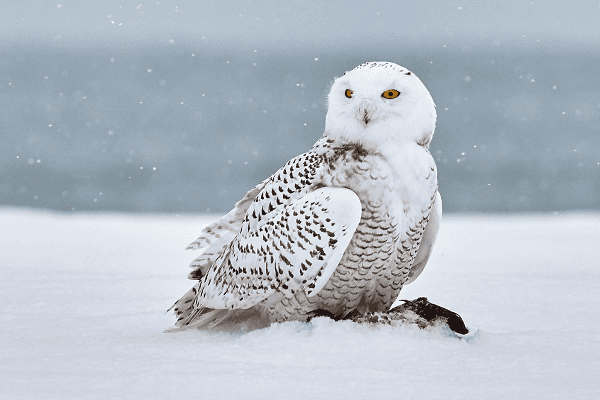
- Length: 20.5-27.9 in (52-71 cm)
- Weight: 56.4-104.1 oz (1600-2950 g)
- Wingspan: 49.6-57.1 in (126-145 cm)
Snowy Owls are a vulnerable species in Michigan, especially during the winter months from December to February. They’re spotted in only about 2% of winter checklists. Nevertheless, there have been a few sightings in places like Midland and Bay City during their breeding season.
Moreover, these iconic Arctic creatures blend perfectly with the snowy landscape, making them adept hunters in their environment.
Snowy Owls boast striking features such as bright yellow eyes, and their legs and feet are entirely covered in feathers to shield them from the extreme cold of the Arctic. Additionally, they have distinct dark bars on their wingtips but incomplete bars on their tails.
Male Snowy Owls are typically either completely white or may have a few brown spots here and there.
In contrast, female Snowy Owls display flecks of dark brown to black on their backs, wings, and flanks, setting them apart from the predominantly white males. Plus, their tails have thicker and more complete barring compared to males.
Furthermore, juvenile Snowy Owls sport extensive brown barring all over their bodies except for their faces, underwings, legs, and feet.
2. Gyrfalcon
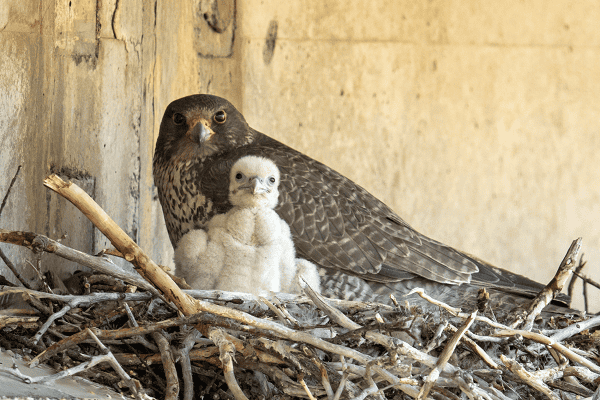
- Length: 20 – 25 in (51 – 64 cm)
- Weight: 41.6 oz (1179 g)
- Wingspan: 48 – 64 in (122 – 163 cm)
Gyrfalcons aren’t commonly seen in Michigan, but a few spend their winters in the northern part of the state from October through April.
Plus, Gyrfalcons, being the largest falcons, rule over the Arctic as top predators. They’re skilled at snatching birds mid-air or diving swiftly to grab prey from the ground.
Their appearance varies, typically falling into three morphs – white, silver/gray, and dark. Among these, the silver/gray morph is most prevalent in North America.
The silver/gray morphs sport heavily banded gray and white feathers on their upper parts, though some may appear mostly gray without distinct banding. Their underparts are evenly spotted with a white throat. When young, they have solid dark heads and a browner overall appearance.
In contrast, the white morph Gyrfalcons are predominantly white with brown or black barring on their upper parts, accompanied by dark wingtips and a white tail. Some individuals may have barring on their tails and spots on their breasts. Juvenile white morphs resemble adults but with more barring on their upper parts and faint streaks on their underparts
| Bird Species | Appearance | Behavior | Habitat |
|---|---|---|---|
| Snowy Owl | White plumage, distinctive white face | Migratory, feeds on small mammals and larger birds | Open habitats, fields, dunes, shores of Great Lakes |
| Gyrfalcon | Largest falcon, white feathers with grayish mottling | Predatory, feeds on birds and small mammals | Remote cliff areas, tundra, rocky coasts |
Wading Birds with White Plumage in Michigan
If you’re a bird enthusiast in Michigan, you’ll be delighted to discover the variety of wading birds Among the large birds with stunning white plumage that can be found in the state is the Trumpeter Swan. These elegant birds are known for their long legs and graceful presence near water bodies. Let’s explore some of the remarkable wading birds you may encounter during your journey across Michigan. birdwatching adventures.
3. Great Blue Heron

Great Blue Herons make their presence known during the breeding season in northern Michigan, but some can also be spotted in the southern part of the state throughout the year. They show up on about 17% of summer checklists and 3% of winter checklists.
These amazing birds, the largest herons native to North America, are truly a sight to behold. Their large size and pale gray bodies, which often appear white as they glide through the air, make them resemble small to medium-sized birds found throughout Michigan.
Adding to their striking appearance, they have a white face adorned with a black crest or plume extending from the front of their eyes to the back of their heads. Their bills sport a yellow-orange hue.
With their long, graceful gray necks adorned with black and white streaks, along with their pale grayish-blue bodies featuring dark wingtips, Great Blue Herons stand out wherever they go. Not to mention their elongated gray legs, perfectly suited for wading in shallow waters.
Interestingly, there’s a white morph subspecies of the Great Blue Heron known as the Great White Heron, primarily found in Florida
4. Great Egret
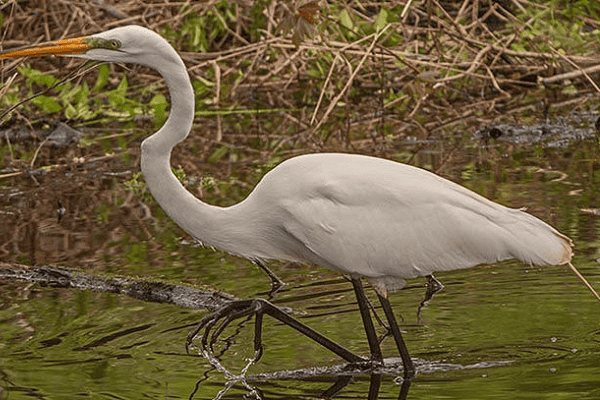
- Length: 46 – 52 in (117 – 132 cm)
- Weight: 128 oz (3628 g)
- Wingspan: 77 – 82 in (196 – 208 cm)
Another captivating wading bird that often draws the attention of bird watchers is the Great Egret. This elegant creature is truly a marvel to behold, adorned in its stunning snowy white plumage and boasting a long, graceful neck.
You can spot the Great Egret in various habitats, including freshwater and saltwater environments such as marshes, swamps, and lakeshores. As you venture through the diverse ecosystems of Michigan, keep an eye out for its striking features, including its distinctive yellow bill and black legs.
5. American White Pelican
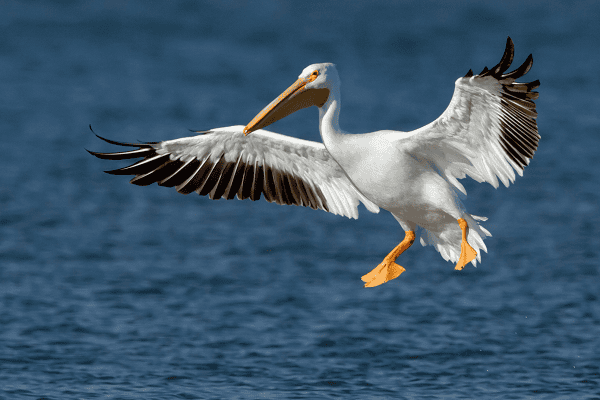
- Length: 60 – 63 in (152 – 160 cm)
- Weight: 246.4 oz (6983 g)
- Wingspan: 96 – 110 in (244 – 279 cm)
While not exclusively found in wetland habitats, the American White Pelican is worth noting for its stunning appearance and close ties to water. This majestic bird, characterized by its large size, pristine white feathers, and impressive wingspan, is a magnificent sight to behold. Keep an eye out for them near larger bodies of water like the Great Lakes, where they gracefully glide across the surface, hunting for fish.
Encountering wading birds adorned in white plumage in Michigan is a delightful experience for any bird enthusiast. Whether you spot the majestic Great Blue Heron, the elegant Great Egret, or the impressive American White Pelican, each encounter is bound to leave a lasting impression. So, don’t forget your binoculars, venture out to explore the wetlands and lakeshores, and allow yourself to be captivated by the beauty of Michigan’s wading birds.
| Wading Birds | Characteristics | Habitats |
|---|---|---|
| Great Blue Heron | Tall stature, long neck, white plumage | Rivers, ponds, marshes |
| Great Egret | Tall, graceful bird with snowy white feathers | Freshwater and saltwater habitats |
| American White Pelican | Large size, white plumage, impressive wingspan | Larger bodies of water, such as the Great Lakes |
Water Birds with White Feathers in Michigan
Michigan’s bodies of water are home to a diverse array of water birds with striking white feathers. These elegant creatures enhance the natural beauty of Michigan’s lakes, ponds, and rivers, captivating birdwatchers with their graceful presence.
One notable water bird with white feathers found in Michigan is the mute swan. With its majestic white plumage and distinctive orange bill, the mute swan is a sight to behold. It is a non-native species that was introduced to the state in the 19th century and has since become a familiar sight across Michigan’s waterways. Mute swans are known for their territorial behavior and can often be seen gracefully gliding across the water.
Another water bird with white feathers that calls Michigan home is the tundra swan. These large and graceful birds are known for their distinctive honking calls and impressive migration journeys. During the breeding season, tundra swans can be found nesting in remote wetlands in northern Michigan. They then embark on a remarkable journey, flying thousands of miles to their wintering grounds along the Gulf Coast.
These water birds with white feathers play an important role in Michigan’s ecosystem, contributing to the state’s biodiversity and enriching its natural heritage. They are not only a visual delight but also serve as indicators of the overall health of Michigan’s aquatic ecosystems.
Behavior and Migration Patterns
Water birds with white feathers in Michigan exhibit fascinating behaviors and migration patterns. The mute swan, for example, is highly territorial and will fiercely defend its nesting area. They build their nests from aquatic vegetation and often choose secluded spots near the water’s edge. Mute swans are known to stay in Michigan year-round.
On the other hand, tundra swans are migratory birds that pass through Michigan during their spring and fall migrations. These magnificent birds travel in large flocks, utilizing a V-formation pattern to conserve energy during their long-distance flights. Their migration is a truly awe-inspiring sight and a testament to the incredible adaptability of these waterfowl.
Breeding Season
Water birds with white feathers in Michigan have specific breeding seasons when their behaviors become even more fascinating. Mute swans, recognized by the Michigan Bird Records Committee, typically begin nesting in late March or early April, with the female laying an average of 4 to 8 eggs. Both parents take turns incubating the eggs and fiercely defend the nest from potential predators.
Tundra swans, on the other hand, begin their breeding season in late May or early June. They construct their nests on elevated ground or on muskrat mounds, using grasses, sedges, and other vegetation. The female tundra swan lays an average of 3 to 5 eggs and both parents participate in incubation duties.
| Water Bird | Behavior | Migration Patterns | Breeding Season |
|---|---|---|---|
| Mute Swan | Territorial, stays year-round | Non-migratory | March to April |
| Tundra Swan | Migratory, travels in flocks | Passes through Michigan during spring and fall migrations | May to June |
Observing water birds with white feathers in Michigan’s bodies of water is a rewarding experience for birdwatchers and nature enthusiasts alike. Whether you catch a glimpse of a mute swan gracefully gliding on a calm lake or witness a V-formation of tundra swans during their migratory journey, these birds provide a sense of wonder and appreciation for the natural world.
Next, we will explore the presence of white birds in Michigan’s forests, where a different group of stunning avian species can be found.
White Birds in Michigan Forests
Michigan’s diverse forests are home to several species of white birds, adding a touch of elegance and beauty to the natural landscapes. These forest-dwelling white birds exhibit fascinating behaviors and play crucial roles in the ecosystem.
6. White-breasted Nuthatch
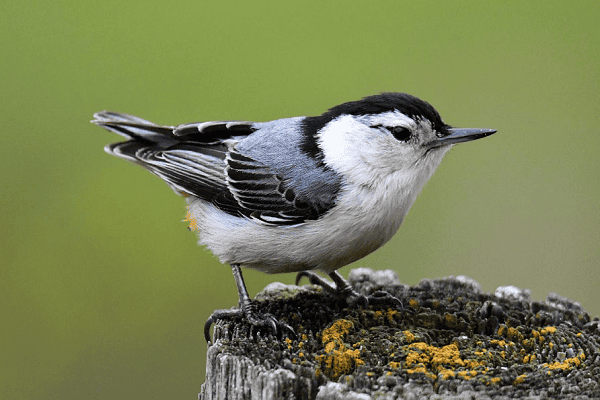
The white-breasted nuthatch (Sitta carolinensis) is a small songbird that can be found in Michigan’s forests. With its white underparts and bluish-gray upperparts, this bird is easily recognizable. It has a unique feeding habit of foraging upside down on tree trunks, thanks to its powerful legs and long claws.
This bird primarily feeds on insects, spiders, nuts, and seeds, commonly found in tree bark crevices. Its strong beak allows it to access these hidden food sources efficiently. The white-breasted nuthatch is a year-round resident in Michigan and can be observed flitting through the forest, emitting its distinctive nasal “yank-yank” call.
7. Snowy Egret
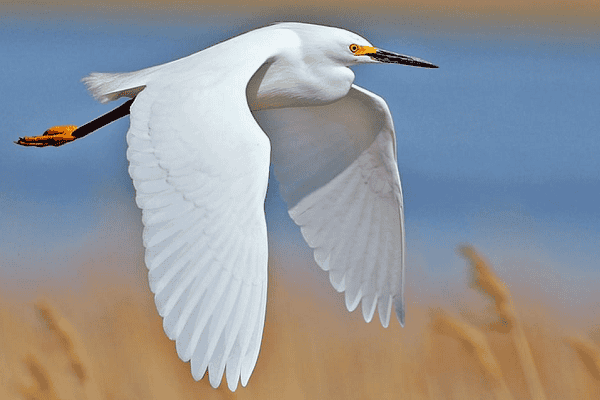
- Length: 37 – 41 in (94 – 104cm)
- Weight: 59.96 oz (1699 g)
- Wingspan: 54 – 55 in (137 – 140 cm)
The snowy egret (Egretta thula) is a graceful wading bird that thrives in Michigan’s wetlands and along the forested borders of rivers and lakes. With its stunning white plumage, this bird stands out as a beautiful inhabitant of the area.
Renowned for its elegant and deliberate stalking movements, the snowy egret delicately hunts for small fish, amphibians, and invertebrates in the shallow waters.
During the breeding season, the snowy egret adorns itself with exquisite plumes on its back and neck. These plumes were once highly coveted for the millinery trade, leading to a decline in the egret population.
Forest Conservation and Birdwatching
Protecting Michigan’s forests is crucial for the survival of these forest-dwelling white birds and other wildlife species. The preservation and restoration of forested areas create suitable habitats for these birds to thrive, ensuring their populations remain stable.
If you’re interested in birdwatching, exploring Michigan’s forests can provide incredible opportunities to observe white birds in their natural environment. Remember to respect their habitats by staying on designated trails and refraining from causing disturbances or damage.
“Birds are indicators of the environment. If they are in trouble, we know we’ll soon be in trouble.” – Roger Tory Peterson, an advocate for bird watching.
By appreciating and protecting the white birds in Michigan’s forests, we contribute to the preservation of these beautiful creatures and the overall health of our forests.
| White Bird Species | Habitat | Feeding Habits | Nesting Behaviors |
|---|---|---|---|
| White-breasted Nuthatch | Deciduous and mixed forests are prime habitats for birds of Michigan including the small bird species. | Forages on tree trunks for insects, nuts, seeds | Builds nests in tree cavities |
| Snowy Egret | Wetlands, forested edges of rivers and lakes | Stalks prey in shallow water, feeds on fish and invertebrates | Builds platform nests in trees near water |
White Birds in Michigan Backyards
Michigan backyards are home to a variety of beautiful white birds that can bring charm and wonder to your outdoor space. Whether you have a small suburban yard or a sprawling rural property, attracting these backyard birds Bird watching is easier than you might think. By providing the right resources and creating a welcoming environment, you can enjoy the presence of these feathered visitors year-round, enhancing your bird watching experiences.
8. Rock Pigeon
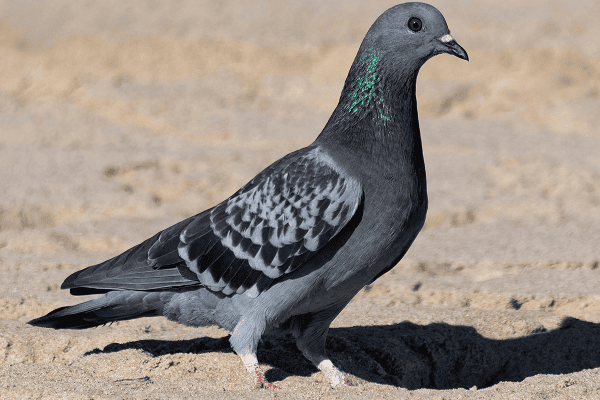
- Length: 11.8-14.2 in (30-36 cm)
- Weight: 9.3-13.4 oz (265-380 g)
- Wingspan: 19.7-26.4 in (50-67 cm)
The rock pigeon, also known as the common pigeon, is a frequent visitor to Michigan backyards. These familiar birds are often seen perched on rooftops or feeding on the ground. They have distinct grayish-white plumage, with iridescent feathers on their necks and wings. Offering a platform feeder or a bird table with a variety of seeds will help attract rock pigeons to your backyard.
9. Common Tern
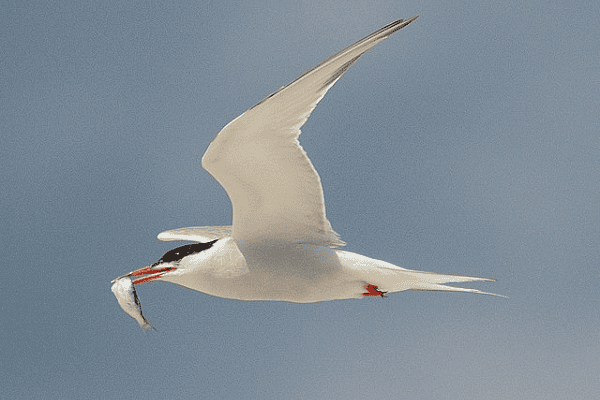
- Length: 13 – 16 in (33 – 41 cm)
- Weight: 5.15 oz (146 g)
- Wingspan: 30 – 31 in (76 – 79 cm)
The common tern is a graceful bird that can be found near lakes, rivers, and coastal areas in Michigan. With its striking black and white plumage and black cap, the common tern is a stunning sight to behold across Michigan. They are skilled divers, often found throughout Michigan, and can frequently be seen plunging into the water to catch small fish. Providing a nearby water source, such as a bird bath or small pond, will help attract common terns to your backyard.
These white birds in Michigan backyards can bring joy and fascination to birdwatching enthusiasts of all ages across Michigan. Their presence adds a touch of natural beauty and can create a peaceful atmosphere in your outdoor space. Remember to keep feeders clean and filled with fresh food, and provide adequate water sources to ensure the well-being of these avian visitors.
| White Birds in Michigan Backyards | Description |
|---|---|
| Rock Pigeon | Familiar birds with grayish-white plumage, often seen perched on rooftops or feeding on the ground, include the little blue heron known for its blue-gray coloration. Attracted to platform feeders or bird tables with a variety of seeds. |
| Common Tern | Graceful birds with striking white plumage and a black cap. They can be found near lakes, rivers, and coastal areas in Michigan. Attracted to nearby water sources, such as bird baths or small ponds, many birds with yellow legs can be found throughout Michigan in summer. |
Rare White Bird Sightings in Michigan
Michigan is home to a diverse array of bird species, including several rare white birds that have been spotted in the state. These extraordinary sightings have captured the attention of birdwatchers and nature enthusiasts alike, offering a glimpse into the enchanting world of these elusive creatures.
One of the remarkable rare white bird sightings In Michigan, one of the birds of Michigan is the majestic Whooping Crane, an iconic trumpeter of the bird world.. This endangered species, with its pure white feathers and striking red crown, is a sight to behold. Known for its distinctive trumpeting call, the Whooping Crane was once on the brink of extinction but has made a remarkable recovery thanks to conservation efforts. It is a true symbol of hope and resilience.
Another fascinating white bird that has been spotted in Michigan is the Ross’s Goose. Smaller than the familiar Canada Goose, this exquisite bird, a cattle egret, boasts beautiful white plumage with a contrasting black head. Commonly found in Arctic regions, the Ross’s Goose occasionally makes its way to Michigan during migration seasons, delighting birdwatchers with its unique presence.
These rare white bird sightings provide a thrilling opportunity for birdwatchers and nature enthusiasts to witness the beauty of these extraordinary creatures up close. They also serve as a reminder of the importance of preserving natural habitats and protecting endangered species.
If you’re eager to experience the wonder of these rare white bird sightings in Michigan, be sure to keep your binoculars handy and explore the following regions where these birds have been recorded:
| Species | Region |
|---|---|
| Whooping Crane | Pointe Mouillee State Game Area |
| Ross’s Goose | Huron County Nature Center |
| Ross’s Goose | Tawas Point State Park |
Visiting these locations may increase your chances of witnessing the rare white bird sightings in Michigan. Remember to respect these birds’ habitats and observe them from a distance, allowing them to thrive undisturbed.
Continue your birdwatching adventure and explore the other sections of this guide to discover more about Michigan’s diverse birdlife. From white birds of prey From wading birds and water birds to the snow bunting and small bird populations, the state’s natural wonders await your discovery.
Tips for Birdwatching White Birds in Michigan
If you’re interested in birdwatching and specifically want to spot white birds in Michigan, we’ve got some helpful tips for you. Michigan is home to a variety of beautiful white birds, including some medium-sized birds, and with the right knowledge, you can increase your chances of seeing them in their natural habitats.
First, timing is key. The best time to go birdwatching for white birds in Michigan is during the early morning or late afternoon. Many white birds are more active during these times, making them easier to spot. Additionally, try to plan your birdwatching trips during the spring or fall migration seasons, as this is when you’re likely to see a greater variety of white birds passing through.
When it comes to locations, Michigan offers diverse landscapes that attract different types of white birds. Head to the Great Lakes shoreline for a chance to spot water birds like swans and gulls. If you prefer forest birds, explore the state’s numerous nature reserves and national parks, such as Sleeping Bear Dunes National Lakeshore or Pictured Rocks National Lakeshore.
Remember to respect the birds’ habitats while birdwatching. Keep a safe distance and avoid disturbing their nesting areas. Binoculars or a camera with a zoom lens can help you observe them without causing any harm. If you’d like more information on birdwatching in Michigan, check out resources like the Michigan Audubon Society or local birding clubs in your area.
10. Ring-billed Gull

- Length: 18 – 19 in (46 – 48 cm)
- Weight: 20.81 oz (590 g)
- Wingspan: 47 – 48 in (119 – 122 cm)
Ring-billed Gulls are a familiar sight in Michigan, making appearances throughout the year. They’re noted in approximately 17% of summer checklists and 11% of winter checklists submitted by keen bird watchers in the state.
These medium-sized gulls are easily recognizable, primarily due to their short, yellow bills featuring a distinctive black ring near the tip.
Breeding adults typically sport a predominantly white plumage, with pale gray backs and wings adorned with black tips and white spots. Their eyes stand out in yellow, bordered with a hint of orange, while their legs and feet boast a matching yellow hue. Interestingly, males and females exhibit similar appearances, often featuring yellow legs in many species found throughout Michigan.
However, non-breeding adults can be differentiated by the light brown streaks adorning their heads and necks.
Meanwhile, juvenile Ring-billed Gulls present a markedly different appearance, covered in brown streaks throughout their bodies.
11. Mute Swan
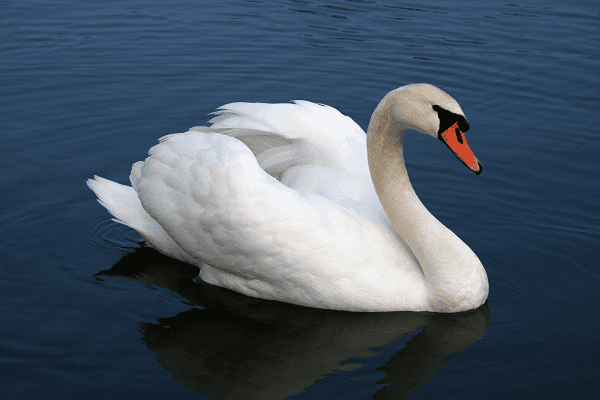
- Length: 56 – 62 in (142 – 157 cm)
- Weight: 416 oz (11789 g)
- Wingspan: 84 – 96 in (213 – 244 cm)
Mute Swans, non-native to Michigan, can be observed in the state throughout the year, making appearances in about 8% of summer checklists and 10% of winter checklists.
These majestic birds, among the largest and heaviest flyers, were initially introduced for ornamental purposes in lakes and ponds. However, they’ve since established themselves in the wild, leading to concerns due to their impact on native wildlife and their sometimes aggressive behavior.
With their striking all-white plumage, and long and graceful necks, Mute Swans are easily identifiable. Their distinctive features include orange bills adorned with a large black basal knob, black markings around the base of the bill, and black legs. Interestingly, adult males tend to be larger than females, although they look quite similar in appearance.
Juvenile Mute Swans, however, differ in some aspects. Instead of the characteristic orange bills, they sport dusky-pinkish bills. Additionally, they may occasionally display dusky-brownish highlights on their bodies, setting them apart from their adult counterparts.
12. Trumpeter Swan
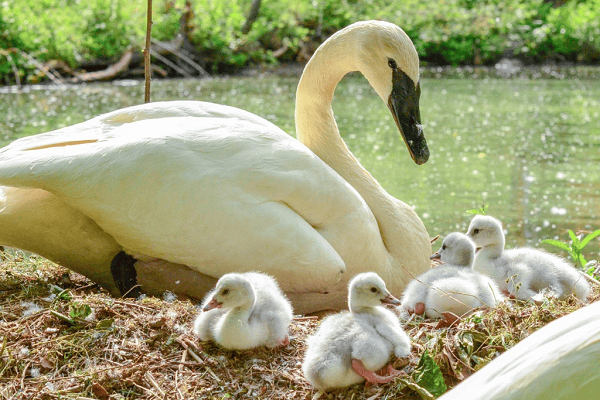
- Length: 58 – 72 in (147 – 183 cm)
- Weight: 401.6 oz (11381 g)
- Wingspan: 72 – 102 in (183 – 259 cm)
Trumpeter Swans, a common sight in Michigan year-round, make up to 3% of both summer and winter bird checklists.
These magnificent birds hold the distinction of being the longest and heaviest native birds in North America, and they’re also known as the heaviest flying bird worldwide.
Easily identifiable by their entirely white plumage, Trumpeter Swans sport striking black bills, legs, and feet, along with a distinctive black patch on their faces that appears to connect their eyes to their bills. Interestingly, their heads and necks may sometimes display a rust-brown hue, a result of their contact with iron elements in wetland soils.
When young, Trumpeter Swans have a mostly dusky-gray appearance, with a pink center on their otherwise black bills.
Must visit: hummingbirds in Michigan
13. Snow Bunting
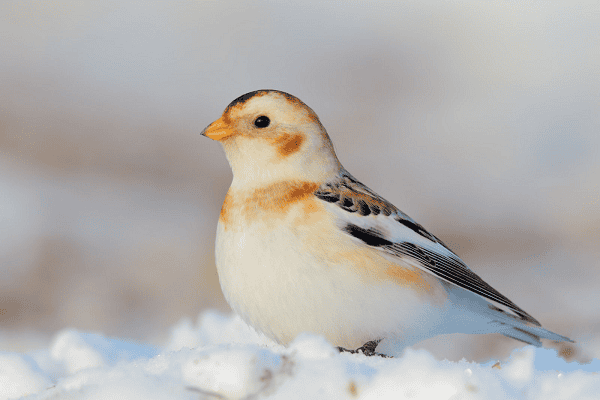
- Length: 6 – 7 in (15 – 17 cm)
- Weight: 1 – 2 oz (28 – 50 g)
- Wingspan: 12 – 14 in (32 – 38 cm)
Snow Buntings are a common sight during the winter months in Michigan, typically seen from October through May, appearing on approximately 2% of winter checklists.
These medium-sized songbirds are social creatures that hail from the high Arctic.
During the breeding season, male Snow Buntings boast an all-white appearance except for black markings on their backs and wings, while females display streaked brown backs and paler undersides.
Outside of the breeding season, both male and female Snow Buntings exhibit similar features, with streaked backs, white undersides, and brown patches on their heads. However, non-breeding females tend to have a more pronounced reddish coloring compared to males.
Juvenile Snow Buntings, on the other hand, are predominantly gray throughout their bodies, with dark wings and lighter gray bellies.
14. Tundra Swan
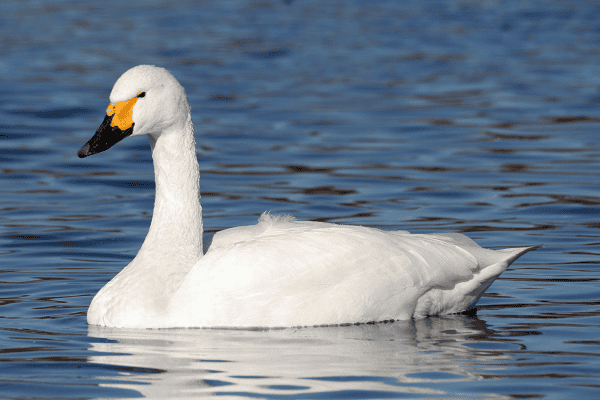
- Length: 487 – 58 in (119 – 147 cm)
- Weight: 370.37 oz (10496 g)
- Wingspan: 72 – 84 in (183 – 213 cm)
Tundra Swans are primarily seen in Michigan during the winter season, from October to April, although a few may stick around all year, showing up in around 1% of winter checklists.
These swans are recognizable by the yellow patches at the base of their bills, although sometimes these markings may not be visible. They boast entirely white bodies, long necks, and striking black bills, legs, and feet.
Juvenile Tundra Swans, also known as Whistling Tundra Swans, have a distinctive appearance. They are pale brown with white highlights and sport a mostly pink bill with a black tip and base.
Also read: Largest Birds of Prey
15. Snow Goose
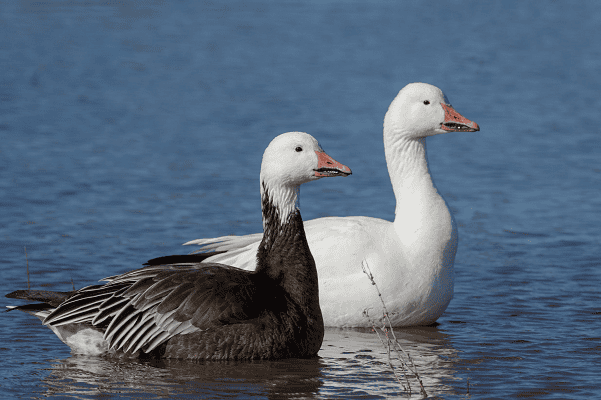
- Length: 25 – 31 in (64 – 79 cm)
- Weight: 81.13 oz (2299 g)
- Wingspan: 54.3 in (138 cm)
Snow Geese are a familiar sight in Michigan throughout the year, although they are more commonly seen during the winter months, from September to March.
These geese are aptly named for their predominantly white plumage, distinguished by their black wingtips, pink bills with a black grin patch, and pink legs and feet.
Interestingly, Snow Geese come in another variant known as the Blue Goose, featuring a white head but a dark blue-gray body. Both variants may occasionally exhibit a “stained” head due to their feeding habits.
Both male and female Snow Geese variants appear similar, although there may be variations in size, with males typically larger than females.
Juvenile Snow Geese of the white morph display a dusky gray-brown coloring, while those of the blue morph are dark gray. Despite these differences, they both retain the characteristic pink bill and black grin patch.
Frequently Asked Questions
Q1. What is the most common bird in Michigan?
The American Robin.
Q2. What are the big white and gray birds in Michigan?
Great Blue Herons.
Q3. What are the white-wading birds in Michigan?
Egrets and Snowy Egrets.
Q4. What bird is only found in Michigan?
The Kirtland’s Warbler.

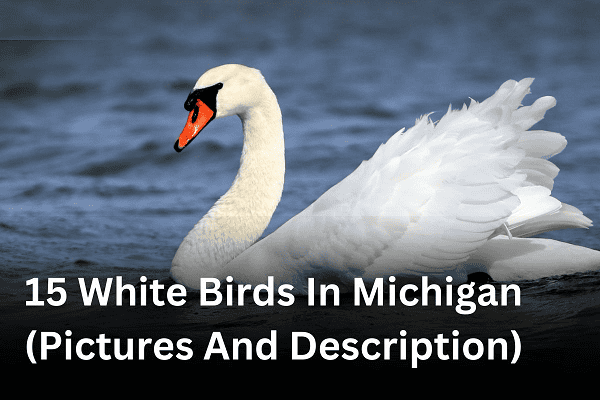

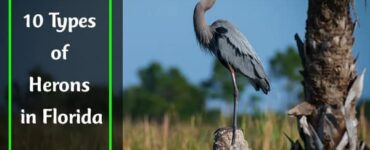
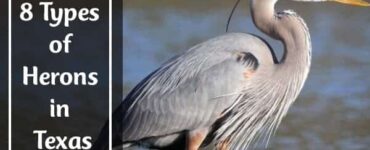
Add comment